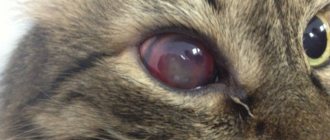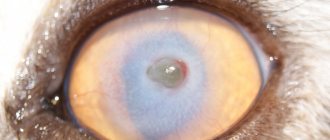All about dogs > Health and illness > If a cat scratches a dog’s eye: what to do and how to help
Many pet lovers have multiple pets at once. It is not uncommon for a cat, a dog, a rat, and even a parrot to live in the same apartment. In most cases, if the animals are properly raised, this neighborhood does not bring any inconvenience to either the owners or the pets.
But there are also cases when your animals can seriously injure each other. Often this happens unconsciously, so to speak, not out of malice. And the cause of these injuries is not always dogs. There are many cases when a cat acts as the offender, and the dog is injured. And in almost one hundred percent of cases, these injuries are associated with the fact that the cat scratched the dog’s eye.
When to seek veterinary help?
An eye injury in a dog is a serious problem that requires immediate attention to a veterinarian. There are various problematic situations in which it is necessary to rush to the veterinarian.
- Getting injured as a result of an unpleasant interaction with a street cat. A fight between an angry cat and a dog can be costly for the animal's health. If in the first hours after the injury your pet rubs its eye vigorously, squints and rushes from side to side in pain, it is necessary to carefully examine it. If, after an injury, clouding of the cornea in the area of injury, changes in the eyeball, or the appearance of blood or pus are clearly visible, you should immediately go to a veterinary clinic, where a specialist will prescribe the appropriate treatment.
- Mechanical damage due to debris, dust, or sand getting into the eye. When a small foreign body penetrates under the third eyelid, severe irritation appears on the cornea of the eye. The dog will try to scratch his eye with his paw and squint all the time. He will experience discomfort and pain. If excessive tearing occurs, the dog owner needs to be wary. In this case, it is necessary to remove a speck of dust or speck from the eye in a veterinary clinic. Otherwise, complications may occur, including blindness.
- Traumatic injury due to penetration of the eye by a sharp object. When a branch, stick or other object gets into the eye, the cornea is damaged and a wound is formed into which various microbes and bacteria penetrate. If the dog has an urgent need to squint, this may also indicate a minor injury. With a strong blow, an injured animal may completely close its eyes and experience pronounced painful sensations. If at the same time purulent or bloody discharge appears in the corners of the eyes, the dog does not allow the eyelid to open and behaves aggressively, you should immediately take him to the veterinary clinic. Timely treatment will save the animal's eye.
This is interesting: Why does a cat hide under the blanket?
First aid
The first steps to prevent the occurrence of irreparable processes in the cornea are the following::
- Under no circumstances should you allow your dog to scratch an injured eye. It is necessary to monitor the animal, and if possible, put a special medical Elizabethan collar on it.
- If an animal is in severe pain, you can alleviate its suffering by dripping the eye with a 2% solution of novocaine
- If you are unable to visit the veterinarian in the near future, we recommend that you administer antibiotic drops to the affected eye. Normax, Torbex, Ciprovet and Gentamicin are optimal. Please note that the dosage of the drug should be accurately calculated according to the weight of the dog.
© shutterstock
Please note that you should never use other drops that differ in composition, especially if they contain corticosteroids, without the appropriate instructions from a doctor. The same applies to tetracycline ointment, which is used only under strict medical supervision.
The use of other drugs that differ in composition from those indicated and contain corticosteroids, as well as eye ointments, including tetracycline, can only be used on the recommendation of a veterinarian. Otherwise, not only will they not help the animal, but, on the contrary, they can irritate the cornea of the eye and cause even greater irritation.
When providing first aid to an animal, do not forget that if a dirty cat’s claw gets into the eye, under no circumstances should you go without a visit to the veterinarian. The presence of a large number of pathogenic bacteria in cat claws increases the risk of vision loss. So is the organ as a whole.
All of the above recommendations should be considered as first aid only. In order to completely eliminate the risk of complications from the injury and provide the most effective ophthalmological treatment of the eye . Without contacting a specialist, the animal may remain disabled for life. Professional, highly qualified treatment is especially important if a young animal is injured.
What are the signs of an eye injury?
Scratches on the eyes of dogs can often be very small and unnoticeable, which means that you need to pay attention to behavior that is not typical for your animal. If your dog whines, shakes his head frequently, or rubs his paw at the top of his muzzle, you should carefully examine his eyes.
Having noticed a scratch, it is best to urgently take your pet to a veterinarian , or even better, take the animal to an ophthalmologist veterinarian. But it often turns out that not all cities have such specialists, so in this case limit yourself to a simple veterinarian specialist.
What not to do
Under no circumstances should you apply any means to stop bleeding or disinfect the injured eye before traveling. Exposure to such drugs will often only worsen your pet's injury, or even make it irreversible. You should not try to blot the surface of the eye with all kinds of napkins, and you should not press on the damaged surface.
Should I be concerned if my cat scratches my dog's eye?
The unequivocal answer is yes, of course it’s worth it . This very unpleasant situation can often lead to loss of vision in your dog, or even loss of an eye. But in many cases, this development of the situation can be avoided if you correctly provide first aid to your wounded pet, which we will talk about here.
Eye removal for glaucoma in a dog
My dog had an eye removed in January 08 due to glaucoma.
Hello. In January 08, my dog had an eye removed due to glaucoma . the seam healed normally and was clean. At the beginning of March, the dog began to scratch it, they noticed that purulent discharge appeared from a small hole that was left from a stitch in the inner corner of the eye, then this hole became even larger, blood began to flow, and pus appeared. This wound has not healed yet (it has festered for more than 2 months). They injected me with antibiotics, applied streptoid ointment (as prescribed by the doctor), and now we are dripping sea buckthorn oil ourselves. Tell me how we can help? The dog eats well, is cheerful, and behaves normally. (Biryukova Natalya Alexandrovna, Ekaterinaburg)
Answer
So, you need to widen the wound, open it, and completely remove the infected contents. And only then carry out antibiotic therapy.
Eye removal in animals
For certain eye diseases in animals, surgery to remove the eye becomes necessary, since the eyeball becomes a source of suffering for the animal, and the pathological processes that develop in it can threaten the health and life of the animal.
Removal of an animal's eye is carried out when the intraocular structures are severely damaged and visual functions cannot be restored. Such diseases include: buphthalmos (terminal glaucoma), penetrating wounds into the eyeball, blunt injuries and contusions, which are combined with damage to the choroid, with extensive hemorrhages and disorders of the retina and vitreous body.
Surgery to remove the eyeball is necessary in cases where therapeutic treatment is pointless. Pathological processes that rapidly develop in an animal’s eye can only be stopped with the help of surgical intervention to relieve the patient of pain and return him to normal life.
Surgery to remove a dog's eye must meet the following requirements:
— minimal injuries;
- low risk of postoperative complications;
- small volume of anesthetic substances;
- short period of pain after surgery;
— satisfactory result;
The methods used to remove a cat's eye are called evisceration, enucleation and exenteration.
Enucleation is the removal of the eyeball, in which the muscular-ligamentous and auxiliary apparatus of the eye is left intact.
Evisceration is the complete removal of the contents of the eyeball and all intraocular structures. After the blood clot dissolves, only the fibrin framework remains in the cavity, which prevents complete atrophy of the eye. Usually after a month, the size of the operated eye becomes significantly smaller than that of a healthy one.
After a year or two after surgery, the fibrinous framework that supports the shape of the eye completely resolves, resulting in complete atrophy, and in some cases the diameter of the eyeball does not exceed 0.5 centimeters.
There are some disadvantages of this method and they are expressed in postoperative inversion of the upper eyelid, inversion and inversion of the lower eyelid, which subsequently leads to injury to the conjunctiva, an increase in mucous and lacrimal secretions. Purulent conjunctivitis may also begin. The gland of the third eyelid, which is normally held between the eye itself and the third eyelid, falls out and can be pinched by the eyelids.
Exenteration is a radical way to eliminate the pathological process in the eye. This technique involves enucleation combined with removal of the extraocular muscles, eyelids, orbital fat, third eyelid, lacrimal gland, and all conjunctival tissues. The cut edges of the eyelids are sewn together. This method is indicated for the treatment of severe purulent processes of the eyeball, orbit, as well as neoplastic processes.
Veterinary
Fairytale bulldogs and their friends
News:
Be vigilant and careful - pink spots on the snow are not potassium permanganate!1. This is ISONIAZID! This poison reacts with water/snow to produce a pink color. Strictly keep your four-legged animals on a short leash. Smell it, and especially not under any circumstances. Mothers with small children need to be extremely careful! Playing with such snow is very dangerous.
Author Topic: Eye diseases in dogs (Read 8767 times)
« : 19 December 2010, 15:31:31 »
Eye diseases in dogs.
A dog's eye consists of an eyeball, then covered by the upper and lower eyelids with eyelashes. The eyelids and the front of the eye are covered with a mucous membrane - the conjunctiva (which forms a fold - the third eyelid). Tear fluid accumulates in the inner corner of the eye and flows through pinholes into the nasal cavity along the lacrimal canal. When blocked (due to inflammation or physiological characteristics), the tear flows onto the front surface of the dog’s muzzle, forming dark “paths”.
In dogs, unlike in humans, it is difficult to determine diseases associated with visual impairment (myopia and farsightedness). Most often, inflammatory diseases of the eye membranes (conjunctivitis, keratitis, blepharitis) are observed in dogs.
Types of injuries
The cornea, sclera and eyelid are the most dangerous and vulnerable to injury areas of your furry friend’s eye. Moreover, the trauma of the first two of them often leads the pet to blindness. Wounds that occur when a foreign body enters the eye are usually divided into the following types:
- Non-penetrating. In this case, the wound channel affects the surface of the cornea, but does not involve deeper layers;
- Penetrating. A dangerous, deep type of damage that can lead to loss of the eye.
In addition, veterinarians divide wounds into simple and complex, with complications and without complications. Surgical intervention is required for complicated wounds, when the injury has led to extensive damage to the cornea and sclera. Surgery for severe mechanical damage is also necessary to remove the remains of the eye.
Wounds that reach the choroid of the eyeball are especially dangerous. Such an injury makes the visual organ vulnerable to harmful infection, which can lead to uveitis (an inflammatory process in the choroid). A bruise that damages the lens is the most serious injury of all; because of it, the animal will most likely become one-eyed.
It is important to understand that even the slightest injury to the eye apparatus can lead to blindness. This is due to the localization of the site of inflammation if it occurs, that is, in the immediate vicinity of the pet’s brain. In addition, any pathology of the eye increases the risk that the dog will eventually develop glaucoma or have increased intraocular pressure. All this inevitably leads to a decrease in visual acuity.
This is interesting: Types of cat clippers
Main symptoms
There are many nerve receptors on the surface of the cornea, which is why the slightest impact on it is accompanied by severe discomfort. This protective reaction helps reduce the duration of traumatic contacts and protects against penetrating damage to the cornea.
Characteristic symptoms of injuries and damage to the outer shell of the eye are:
- intense lacrimation;
- intolerance to bright light;
- blepharospasm (uncontrolled tension of the eyelid muscles);
- pain that feels like sand in the eyes;
- partial loss of vision, inability to focus;
- redness of the mucous membranes of the eyelids, the appearance of a vascular pattern on the sclera.
With deep penetrating wounds of the eyes, when the destructive process affects the optic nerves, the clinical picture is complemented by intense headache, nausea, and dizziness.
Symptoms
Mechanical damage to the visual organ is characterized by the sudden onset of symptoms. At the same time, the pet’s eyelids swell, the eye itself turns red, the animal becomes restless and constantly tries to wipe the damaged area with its paws. Sometimes the owner may notice blood stains in the injured area. The easiest way to detect damage is if a foreign object, such as a blade of grass or a small midge, gets into your pet's eye.
The severity of the injury can be checked using an ordinary flashlight. It is enough to direct a beam of light into the damaged eye and see if the pupil has dilated. If there is no reaction, then the injury is very serious, and the animal must be urgently taken to a doctor for examination.
With such signs, when the eyeball becomes dark or protrudes beyond the orbit, we can say with confidence that pathogenic microflora has entered the tissue. An animal with such symptoms requires prompt and qualified treatment.
Corneal injury is a very serious pathology that can lead to blindness in a dog. The main signs of such damage are that the dog constantly squints his eyes. He may experience uncontrollable spasms of the eyelids and photophobia. Under no circumstances should you let your pet scratch the damaged area. Against the background of injury, keratitis can develop, an inflammation that leads to clouding of the cornea.
Why are scratches from a cat dangerous?
Scratches from cats and bites from these domestic pranksters are much more infected than bites from domestic dogs. In the overwhelming majority, infectious agents located on the paws and claws of cats are not isolated. Polymicrobial flora contains streptococcal infection, staphylococcal bacilli, pasteurella and some others. It is worth noting that bacterial pathogenic microorganisms are present on the paws and claws of all cats, without exception, even the most domestic and well-groomed ones.
In addition to the bacteria described above, after a scratch a person may develop the so-called felinosis, or cat scratch fever. The marks left by a cat on the owner's body are not harmless. Cat scratch disease can cause quite serious allergic reactions in humans and provoke dangerous complications in the organs of the human body.
The spread of pathogenic bacterial pyogenic microflora is due to the fact that the claws of domestic and wild cats have a curved shape. With the help of its weapon, the cat breaks the surface layer of the dermis. As a result of the penetration of pathogenic microflora that provokes BCC, first of all, the size of the lymph nodes changes. Wounds caused by a cat take a long time to heal, as they are not even.
Cat scratches have jagged edges, which delays the regeneration and recovery process. Deep torn scratches transform into a closed type of damage. It accumulates dirt and pathogens. Before treating a wound surface formed by a cat’s claws, it is necessary to thoroughly treat it to remove all kinds of dirt and infection, which will allow the body to easily regenerate the damaged area with new tissue.
Treatment options
First of all, the owner must completely protect the pet from scratching the damaged area.
. To do this, you can put a muzzle on him and try to calm him down. It is acceptable to use mild sedatives to make the animal feel more confident. It is important to try to get your pet to a veterinary clinic as quickly as possible, only there they will be able to provide qualified assistance.
Under no circumstances should you attempt to treat your dog yourself, including removing a foreign object from its eye. This can damage the cornea and cause scleral rupture.
- If the dog has been wounded in the eye by a cat's claw, then it is permissible to wash the damaged organ with a decoction of calendula and chamomile. It is also important to rinse the other, healthy eye to prevent possible infection. At the veterinary hospital, a specialist will carefully examine the injury and determine further treatment. If the wound is not very deep, then eye drops are prescribed that can relieve irritation, as well as antiseptic lotions for rinsing. The pet must be under the supervision of a doctor for 8-12 days. If suppuration suddenly begins, the animal is prescribed a course of antibiotics.
- If some small particle (a piece of bark, a grain of sand) gets into the dog’s eye, the owner needs to rinse the injured organ with ordinary warm water. At the clinic, the doctor will additionally treat the eye and apply a solution of novocaine (2%) to relieve pain in the shaggy fidget. After this, procedures are carried out to finally remove the foreign object from the eye. Finally, antimicrobial drops are instilled into the eye to prevent infection from developing there.
- If an animal runs into something sharp with its eye, for example, a blade of grass or a twig, and the object itself remains inside, then immediate surgery is needed. Before this, the pet is put into a state of anesthesia, after which the object is removed. Subsequent therapy consists of antibiotics and non-steroidal anti-inflammatory drugs.
Finally, I would like to say that dogs are very active and cheerful animals that love to run, jump and chase cats. Unfortunately, each of these characteristics of the temperament of four-legged pets negates any prevention of eye injuries. Therefore, the owner should have in his first aid kit the basic medications to eliminate the first symptoms of such wounds, as well as the number of the nearest veterinary clinic where the pet can be helped.
Dogs often suffer eye injuries. This can be the result of a walk in a field with tall, coarse grass or in the forest when the dog, in the excitement of the hunt, does not notice a twig or branch, fights with relatives or with cats, car accidents or other accidents.
Injuries to the eye can be superficial (corneal trauma) or penetrating. Corneal injuries occur more frequently and, unless corneal perforation occurs, have a better prognosis. The most common cause of corneal injury is cat scratches.
Blunt trauma to the eye, in which the traumatic object does not penetrate the eye itself, can lead to prolapse of the eyeball, bleeding into the anterior chamber of the eye (hephema), dislocation of the lens, retinal detachment, fracture of the orbital bones, and rupture of the eyeball.
Acute eye injury occurs when pierced by a sharp object (cat's claw, thorn, twig, sharp toys, etc.). Such an injury is accompanied by lacerations of the eyelids, conjunctiva, sclera, penetrating injury to the cornea, hephema, displacement of the lens, etc.
An animal can get an eye injury at any age, but puppies and young dogs are more likely to suffer from eye damage because they are more active and less cautious. Also at risk are dogs of brachycephalic breeds with large bulging eyes (pugs, French bulldogs, Pekingese, etc.).
Prevention
There is no one hundred percent guarantee that a pet will never be injured, but loving owners are responsible for it and must make efforts to minimize such risks.
It is important to choose the right places for walking with your animal, to avoid abandoned construction sites and overgrown paths in park areas.
Hunters need to choose the right breed of dog, since much depends on what animal is being hunted and what is required from the dog.
During play, you should follow safety precautions when working with an animal and not expose it to unnecessary risk of injury.
It is also worth excluding contacts with unfamiliar and especially stray dogs as much as possible. It is necessary to limit possible meetings with felines (unless this is a dog’s best friend). Otherwise, your pet may suffer from sharp claws.
Penetration of a sharp foreign object into the eye
Many dogs injure their eyes from low-hanging tree branches or sharp grass. In case of minor damage, the injured eye is treated with a weak solution of potassium permanganate and antiseptic ointment. A course of treatment with antimicrobial drugs is prescribed.
How to remove a foreign body if a large tree branch protrudes from the conjunctival cavity, sharp grass is stuck into the cornea, or small remains of a claw are clearly visible in the cornea? In this case, immediate surgery is performed. Before surgery, mandatory anesthesia is performed, taking into account the breed and weight of the animal. After surgery, non-steroidal anti-inflammatory drugs and antibiotics are prescribed.
Remember that traumatic eye injuries in dogs can lead to irreversible consequences.
Take care of your animals’ organs of vision and try to create all the necessary conditions for their safety. If an injury occurs, do not treat it yourself, but seek immediate veterinary attention.
Symptoms
Please note that you will not always witness exactly how the incident occurred. At the same time, the scratch may be small and invisible, which will not allow you to immediately examine it. The fact of corneal damage can be detected by focusing on the behavior of the animal. If a cat hits a dog in the eye, the latter will be:
- Whine
- Shake your head frequently
- Rub the area around the eyes with your paw
Of course, it is much better to take your dog to the vet immediately, ideally straight to an ophthalmologist. However, given that not every city has a veterinarian, let alone highly specialized specialists, it is important to know how to provide first aid to an animal yourself.
Treatment
If you suspect an eye injury, you should take your dog to a veterinary clinic as soon as possible. The dog is in severe pain and discomfort; do not attempt to examine or treat the injured eye yourself. Before being examined by a doctor, it is necessary to protect the dog’s eye from additional injury (protective collar). Do not use any eye medications without a doctor's prescription. For corneal wounds, any additional impact to the head, neck, or eye can result in corneal rupture.
No matter how well dog owners take care of their pets (read more about how to care for a dog from an early age), unfortunately, no one is immune from illnesses and accidents. Therefore, often an ordinary walk and play with a pet ends in sad consequences for him. A dog, walking on the street, may stumble upon a tree branch, injure its eye with sharp grass, and perhaps its “friendship” with a neighbor’s cat again goes through a period of testing, as a result of which the dog suffers from the sharp claws of a representative of the feline family. Be that as it may, today we would like to focus on situations when your pet suffers an eye injury. How to behave in this situation, how to help the dog, which specialist should I consult? We will try to answer all these questions in our article...
One of the most dangerous types of injuries are eye injuries. After all, even if the eye injury itself may be harmless and mild, but in the absence of an adequate course of treatment and failure to provide first aid, the disease can progress and have serious consequences for the life and health of your pet. Up to complete loss of vision. That's why,
If you notice that your four-legged friend has an eye injury (regardless of the severity of the injury), it is recommended to immediately show the animal to a specialist.
Moreover, the help of a veterinarian alone will not be enough here; you need a veterinarian-ophthalmologist who, using special equipment, will be able to determine the severity and extent of eye injury, as well as possible consequences. At the same time, the sooner you find such a specialist and contact him for advice, the better for your pet, since in case of eyeball injuries, it’s not just days, but hours from the moment of injury, and they decide the fate of your dog’s injured eye.
Why can’t you turn to an ordinary veterinarian for help? Isn’t his general knowledge enough to examine the animal, make a diagnosis and prescribe treatment?
The fact is that without the availability of special ophthalmological devices, the veterinarian will not be able to thoroughly examine the dog’s injured eye and make the correct diagnosis. Therefore, this must be a veterinarian ophthalmologist, and if necessary, if the dog needs to undergo eye surgery, he will also need an operating microscope, special microsurgical instruments and a microsurgeon - all this, as a rule, is not available in ordinary veterinary clinics...
If, unfortunately, there is no such specialist with special equipment in your city, you should at least contact an ordinary veterinary clinic.
Diagnostics
When making a diagnosis, the doctor takes into account the history and physical examination.
This is especially important in case of blunt trauma to the eye, since, in addition to the eye, the vital organs of the animal can be seriously injured (for example, in a car accident or other strong impact). A chest x-ray and abdominal ultrasound may be recommended
The presence of signs of trauma to the facial region (orbit, nose, oral cavity) is assessed. An X-ray of the head may be required.
A complete ophthalmological examination is performed and a fluorescein test is used to identify corneal defects. If necessary, ultrasound of the eye. Due to severe pain, the patient may need to be sedated for examination if local anesthetics are not sufficient.
If a traumatic brain injury is suspected, a neurological examination is performed.
Additionally, a CT or MRI of the head may be required.











